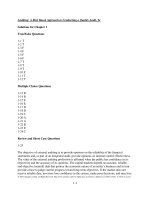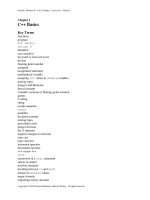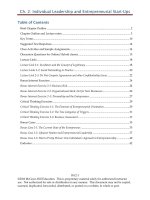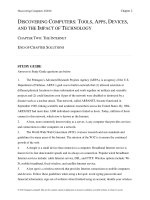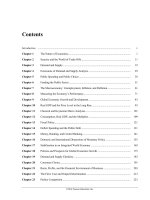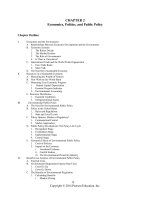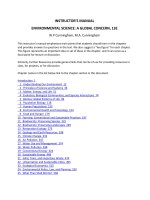Test bank and solution manual of concepts in enterprise resouece planning 4e (1)
Bạn đang xem bản rút gọn của tài liệu. Xem và tải ngay bản đầy đủ của tài liệu tại đây (87.53 KB, 12 trang )
Concepts in Enterprise Resource Planning, 4th edition
2-1
Chapter 2
The Development of Enterprise Resource Planning Systems
At a Glance
Instructor’s Manual Table of Contents
•
Overview
•
Objectives
•
Teaching Tips
•
Quick Quizzes
•
Class Discussion Topics
•
Additional Projects
•
Additional Resources
•
Key Terms
Concepts in Enterprise Resource Planning, 4th edition
2-2
Lecture Notes
Overview
Use this chapter to help students understand how and why ERP systems came into being and
what the future might hold for business information systems. The chapter follows this
sequence:
Review of the evolution of information systems
and related causes for the recent development of ERP systems
Discussion of the few ERP software vendors that
dominate the market; the current industry leader, German software maker SAP AG’s
industry-leading software product, SAP ERP, is discussed as an example of an ERP
system.
Review of the factors influencing a company’s
decision to purchase an ERP system
Description of ERP’s benefits
Overview of frequently asked questions related to
ERP systems
Discussion of the future of ERP software,
including the emphasis being placed on mobile applications and accessibility of data
Objectives
•
•
•
•
Identify the factors that led to the development of Enterprise Resource Planning (ERP)
systems
Describe the distinguishing modular characteristics of ERP software
Discuss the pros and cons of implementing an ERP system
Summarize ongoing developments in ERP
Teaching Tips
The Evolution of Information Systems
1. Begin the discussion by introducing the term silos.
2. Note that such unintegrated systems might work well within each individual functional
area, but to be competitive, a company must share data among all the functional areas.
When a company’s information systems are not integrated, costly inefficiencies can
result.
3. It is important to point out that current ERP systems evolved as a result of three things:
(1) the advancement of the hardware and software technology (computing power,
memory, and communications) needed to support the system, (2) the development of a
vision of integrated information systems, and (3) the reengineering of companies to
shift from a functional focus to a business-process focus.
Concepts in Enterprise Resource Planning, 4th edition
2-3
Computer Hardware and Software Development
1. Introduce Moore’s Law. Use Figure 2-1 to aid the discussion.
2. Point out that the computer hardware and software developments of the 1960s, 1970s,
and 1980s paved the way for the development of ERP systems.
Early Attempts to Share Resources
1. Introduce the terms client-server architecture, scalability, and database management
system (DBMS).
The Manufacturing Roots of ERP
1. Introduce the terms material requirements planning (MRP) and electronic data
interchange (EDI).
Teaching
Tip
To learn about EDI, visit: />
Management’s Impetus to Adopt ERP
1. The hard economic times of the late 1980s and early 1990s caused many companies to
downsize and reorganize. These company overhauls were one stimulus for ERP
development. Use the Mountaineering example on page 23 to aid the discussion.
2. Use the functional business model shown in Figure 2-2 to illustrate the concept of silos
of information.
3. Explain that the functional model was very useful for decades, and it was successful in
the United States where there was limited competition and where flexibility and rapid
decision making were not requirements for success. In the quickly changing markets of
the 1990s, however, the functional model led to top-heavy and overstaffed
organizations incapable of reacting quickly to change. Use Figure 2-3 to aid the
discussion.
Quick Quiz 1
1. ____ means that the capacity of a piece of equipment can be increased by adding new
hardware.
Answer: Scalability
Concepts in Enterprise Resource Planning, 4th edition
2-4
2. The software that holds that data in an organized fashion, and that allows for the easy
retrieval of data, is the ____.
Answer: database management system (DBMS)
3. ____ is a production-scheduling methodology that determines the timing and quantity
of production runs and purchase-order releases to meet a master production schedule.
Answer: Material requirements planning (MRP)
4. The term _____ refers to the direct computer-to-computer exchange of standard
business documents
Answer: electronic data interchange (EDI)
ERP Software Emerges: SAP and R/3
1. Explain that in 1972, SAP founders recognized that all companies developing computer
software faced the same basic business problems, and each developed unique, but
similar, solutions for their needs in payroll processing, accounting, materials
management, and other functional areas of business. SAP’s goal was to develop a
standard software product that could be configured to meet the needs of each company.
SAP Begins Developing Software Modules
1. Explain that before leaving IBM, Plattner and Hopp had worked on an order-processing
system for the German chemical company ICI. The order-processing system was so
successful that ICI managers also wanted a materials and logistics management system a system for handling the purchase, receiving, and storage of materials - that could be
integrated into the new order-processing system.
2. Introduce the term software modules.
3. Discuss the history of SAP – how it was founded.
4. Note that in 1978, SAP began developing a more integrated version of its software
products, called the R/2 system. In 1982, after four years of development, SAP released
its R/2 mainframe ERP software package.
SAP R/3
1. In 1988, SAP realized the potential of client-server hardware architecture and began
development of its R/3 system to take advantage of client-server technology. The first
version of SAP R/3 was released in 1992. Each subsequent release of the SAP R/3
software contained new features and capabilities.
2. Introduce the term open architecture.
New Directions in ERP
Concepts in Enterprise Resource Planning, 4th edition
2-5
1. Begin this section by explaining that in the late 1990s, the year 2000, or Y2K, problem
motivated many companies to move to ERP systems. As it became clear that the date
turnover from December 31, 1999, to January 1, 2000, could wreak havoc on some
information systems, companies searched for ways to consolidate data, and ERP
systems provided one solution.
2. Point out that the Y2K problem originated from programming shortcuts made by
programmers in the preceding decades.
3. Introduce the term legacy systems.
PeopleSoft
1. Explain that PeopleSoft was founded by David Duffield, a former IBM employee who,
like SAP’s founders, faced opposition to his ideas from IBM management. PeopleSoft
started out offering software for human resources and payroll accounting, and it
achieved considerable success, even with companies that already were using SAP for
accounting and production. In fact, PeopleSoft’s success caused SAP to make
significant modifications to its Human Resources module.
Oracle
1. Oracle is now SAP’s biggest competitor. Explain that Oracle began in 1977 as Software
Development Laboratories (SDL). Its founders, Larry Ellison, Bob Miner, and Ed
Oates, won a contract from the Central Intelligence Agency (CIA) to develop a system,
called Oracle, to manage large volumes of data and extract information quickly.
2. Point out that much of Oracle’s recent growth in ERP applications has been through
acquisition. In addition to PeopleSoft and JD Edwards, in 2005 Oracle acquired Siebel,
a major customer relationship management (CRM) software company.
3. Note that in 2010, in an effort to consolidate its customer base on a single software
platform, Oracle released Fusion Applications, which is a software suite designed to
give its PeopleSoft, JD Edwards, and Siebel customers a modular and flexible upgrade
path to a single Oracle ERP solution.
SAP ERP
1. SAP ERP software (previous versions were known as R/3, and later, mySAP ERP) has
changed over the years, owing to product evolution - and for marketing purposes. The
latest versions of ERP systems by SAP and other companies allow all business areas to
access the same database eliminating redundant data and communications lags. Use
Figure 2-4 to aid the discussion.
2. Note that an ERP system allows data to be entered once, and then used throughout the
organization. In information systems, errors most frequently occur where human beings
interact with the system. ERP systems ensure that data are entered only once, where
they are most likely to be accurate. Use examples to aid the discussion.
Concepts in Enterprise Resource Planning, 4th edition
2-6
3. Use Figure 2-5 to discuss the major functional modules in the current SAP ERP system,
also known as SAP ECC 6.0.
4. Discuss the following basic functions of the modules:
The Sales and Distribution (SD) module
The Materials Management (MM) module
The Production Planning (PP) module
The Quality Management (QM) module
The Plant Maintenance (PM) module
The Asset Management (AM) module
The Human Resources (HR) module
The Project System (PS) module
The Financial Accounting (FI) module
The Controlling (CO) module
5. Introduce the term Workflow (WF) module.
Teaching
Tip
To learn about SAP workflow, visit: />
SAP ERP Software Implementation
1. Explain that a truly integrated information system requires integrating all functional
areas, but for various reasons, not all companies that adopt SAP software use all of the
SAP ERP modules. Use examples to aid the discussion.
2. Generally, a company’s level of data integration is highest when the company uses one
vendor to supply all its ERP modules. Note that when a company uses modules from
different vendors, additional software must be created to get the modules to work
together.
3. After a company chooses its major modules, it must make an incredible number of
decisions on how to configure the system. These configuration options allow the
company to customize the modules it has chosen to fit its needs. Use examples to aid
the discussion.
Features of SAP ERP
1. Not only was SAP ERP the first software to deliver real-time ERP integration, it has
other features worthy of note. Note that its most significant characteristics are its
suitability for large companies, high cost, automation of data updates, and applicability
of best practices.
Concepts in Enterprise Resource Planning, 4th edition
2-7
2. Explain that the modular design of SAP ERP is based on business processes, such as
sales order handling, materials requirement handling, and employee recruiting. When
data are entered into the system, data in all related files in the central database are
automatically updated. No further human input is required to make the changes.
ERP for Midsized and Smaller Companies
1. Explain that by 1998, most of the Fortune 500 companies had already installed ERP
systems, so ERP vendors refocused their marketing efforts on midsized companies
(those with fewer than 1,000 employees). Small and midsized companies represented a
ripe, profitable market.
2. To address the needs of smaller companies, such as those with less than 500 employees,
SAP purchased the ERP system of Israeli-based TopManage Financial Systems in 2002,
and renamed this package SAP Business One.
3. Note that SAP has developed its BusinessByDesign product, which is an ERP product
hosted by SAP and accessed through a Web browser. It is an example of the softwareas-a-service (SaaS) approach that eliminates the need for a company to buy and
maintain the software and hardware to run an ERP application.
Responses of the Software to the Changing Market
1. Discuss the reason for the development of the Accelerated SAP (ASAP)
implementation methodology.
2. Introduce SAP’s Business Warehouse (BW) product. Note that the tools used to analyze
data in the BW system are known as business intelligence (BI). Use examples to aid the
discussion.
3. The SAP ERP system provides some tools to manage customer interactions and analyze
the success of promotional campaigns, but SAP also sells a separate application called
Customer Relationship Management (CRM), which has extended customer service
capabilities.
Choosing Consultants and Vendors
1. Explain that before choosing a software vendor, most companies study their needs and
then hire an external team of software consultants to help choose the right software
vendor(s) and the best approach to implementing ERP.
The Significance and Benefits of ERP Software and Systems
1. Discuss the benefits of ERP systems.
2. Note that an ERP system can dramatically reduce costs and improve operational
efficiency. Use examples to aid the discussion.
Concepts in Enterprise Resource Planning, 4th edition
2-8
Questions About ERP
How Much Does an ERP System Cost?
1. Discuss the factors involved in the total cost of an ERP system implementation.
Should Every Business Buy an ERP Package?
1. Explain that ERP packages imply, by their design, a certain way of doing business, and
they require users to follow that way of doing business. For a particular business, some
of its operations - or certain segments of its operations - might not be a good match with
the constraints inherent in ERP. Therefore, it is imperative for a business to analyze its
own business strategy, organization, culture, and operation before choosing an ERP
approach.
2. Note that ERP systems are popping up in some unlikely industries. The government of
Singapore is implementing an ERP project that will link 20 different healthcare
providers together under one system, which is estimated to be 20 percent more efficient
and will eliminate a tremendous amount of duplicate information.
Is ERP Software Inflexible?
1. Introduce the term Advanced Business Application Programming (ABAP).
2. Note that once an ERP system is in place, trying to reconfigure it while retaining data
integrity is expensive and time consuming. That is why thorough pre-implementation
planning is so important. It is much easier to customize an ERP program during system
configuration, before any data have been stored.
What Return Can a Company Expect from Its ERP Investment?
1. Use the information on page 39 to discuss the ways in which an ERP investment can be
measured and interpreted.
How Long Does It Take to See a Return on an ERP Investment?
1. Introduce the term return on investment (ROI).
2. In the Peerstone Research study, 63 percent of companies that did perform the
calculation reported a positive ROI for ERP. Note that manufacturing firms are more
likely to see a positive ROI than government or educational organizations. However,
most companies reported that nonfinancial goals were the primary motivation for their
ERP installations.
Concepts in Enterprise Resource Planning, 4th edition
Teaching
Tip
2-9
To learn about return on investment, visit:
/>
Why Do Some Companies Have More Success with ERP Than Others?
1. Point out that a bumpy rollout and low ROI are caused by people problems and
misguided expectations, not computer malfunctions. Use the examples on pages 40-41
to aid the discussion.
2. Many ERP implementation experts emphasize the importance of proper education and
training for both employees and managers. Note that most people will naturally resist
changing the way they do their jobs.
3. An important point to make is one noted by Nestlé’s former vice president and CIO, Jeri
Dunn: “When you move to SAP, you are changing the way people work…. You are
challenging their principles, their beliefs, and the way they have done things for many,
many years.”
The Continuing Evolution of ERP
1. Explain that ERP systems have been in common use only since the mid-1990s. As this
young technology continues to mature, ERP vendors are working to solve the
adaptability problems that plague customers. The growth in the computing power of
mobile devices such as smartphones and tablets will create more opportunities for ERP
companies to develop applications that provide customers with instantaneous data while
improving their efficiency.
Quick Quiz 2
1. A(n) ____ is an assessment of an investment project’s value, calculated by dividing the
value of the project’s benefits by the project’s costs.
Answer: return on investment (ROI)
2. In ____ third-party software companies are encouraged to develop add-on software
products that can be integrated with existing software.
Answer: open architecture
3. The ____ module is a set of tools that can be used to automate any of the activities in
SAP ERP.
Answer: Workflow (WF)
4. The term ____ is used to describe the best, most efficient way of handling a certain
business process.
Answer: best practice
5. ____ integrates business functional areas with one another.
Concepts in Enterprise Resource Planning, 4th edition
2-10
Answer: Enterprise Resource Planning (ERP)
Class Discussion Topics
1. What is the difference between material requirements planning (MRP) and enterprise
resource planning systems?
2. How long does it take to implement an ERP solution?
Additional Projects
1. Submit a report that discusses the possible reasons why a large percentage of companies
that have implemented ERP have not had a truly successful implementation on their
first attempt.
2. Submit a report that discusses some of the problems experienced by companies that
have attempted to implement ERP.
Additional Resources
1. Clients and Servers: />2. SAP ERP: />3. Return on investment: />4. Moore’s law and mobile networks:
/>
Key Terms
¾ Advanced Business Application Programming (ABAP) The SAP ERP internal
programming language.
¾ Asset Management (AM) module A module in SAP ERP that helps a company
manage fixed-asset purchases (plant and machinery) and related depreciation.
¾ best practice The best, most efficient way of handling a certain business process.
¾ client-server architecture A central computer–local computer arrangement in which
data stored in a central computer (a server) are downloaded to a local PC (a client of the
server) where data are processed. Historically, client-server architecture replaced many
companies’ mainframe-based architecture.
Concepts in Enterprise Resource Planning, 4th edition
2-11
¾ controlling (CO) module A module in SAP ERP that is used for internal management
purposes. The software assigns a company’s manufacturing costs to products and to
cost centers, facilitating cost analysis.
¾ database management system (DBMS) The technology that stores database records in
an organized fashion and allows for the easy retrieval of the data.
¾ electronic data interchange (EDI) A computer-to-computer transfer of standard
business documents that allows companies to handle the purchasing process
electronically, avoiding the cost and delays resulting from paper-based systems.
¾ Financial Accounting (FI) module Accounting processes that deal with documenting
the transactions of a company that have an impact on the financial state of the
organization. The documented transactions form the basis for financial statements for
external parties and agencies.
¾ Human Resources (HR) module A functional area of business that manages
recruiting, training, evaluating, and compensating employees.
¾ legacy system An older and often outdated information system.
¾ material requirements planning (MRP) A production-scheduling methodology that
determines the timing and quantity of production and purchase-order releases to meet a
master production schedule. This process uses the bill of material, lot-size data, and
material lead times.
¾ Materials Management (MM) module A module in SAP ERP that manages the
acquisition of raw materials from suppliers (purchasing) and the subsequent handling
and storage of raw materials, work in process, and finished goods.
¾ modules Individual programs that can be purchased, installed, and run separately, but
that all extract data from the common database.
¾ open architecture Software that allows integration with third-party software. SAP ERP
is an example of open-architecture software. The term can also be applied to hardware
products.
¾ Plant Maintenance (PM) module A module in SAP ERP that allows planning for
preventive maintenance of plant machinery and managing maintenance resources, so
equipment breakdowns are minimized.
¾ Production Planning (PP) module A module in SAP ERP that maintains production
information; production is planned and scheduled, and actual production activities are
recorded.
¾ Project System (PS) module A module in SAP ERP that allows for the planning and
control of new R&D, construction, and marketing projects. This module allows for
costs to be collected against a project budget, and it can be used to manage the
implementation of ERP itself.
¾ Quality Management (QM) module A module in SAP ERP that helps companies plan
and record quality-control activities, such as product inspections and material
certifications.
¾ R/3 The first integrated information system released by German software vendor SAP
in 1992; now called SAP ERP. This ERP system contains the following main modules,
which can be implemented as a group or selectively: Sales and Distribution (SD),
Materials Management (MM), Production Planning (PP), Quality Management (QM),
Plant Maintenance (PM), Human Resources (HR), Financial Accounting (FI),
Controlling (CO), Asset Management (AM), Project System (PS), and Workflow (WF).
¾ return on investment (ROI) An assessment of a project’s value calculated by dividing
the value of the project’s benefits by the project’s cost.
Concepts in Enterprise Resource Planning, 4th edition
2-12
¾ Sales and Distribution (SD) module A module in SAP ERP that records sales orders
and scheduled deliveries.
¾ SAP ERP ERP software produced by SAP; previous versions were known as R/3 and
mySAP ERP.
¾ scalability A characteristic of an information system that indicates the system’s
capacity can be extended by adding servers to the network, rather than replacing the
entire system. Scalability is a characteristic of client-server networks, but usually not of
mainframe-based systems.
¾ silo An unintegrated information system configuration in which individual business
functional areas each have their own hardware, software, and methods of processing
data and information.
¾ tolerance group A range that defines limits on the transactions that an employee can
process.
¾ Workflow (WF) module A module in SAP ERP that can be used to automate any of
the activities in SAP ERP. It can perform task-flow analysis and then prompt employees
(by e-mail) if they need to take action.
